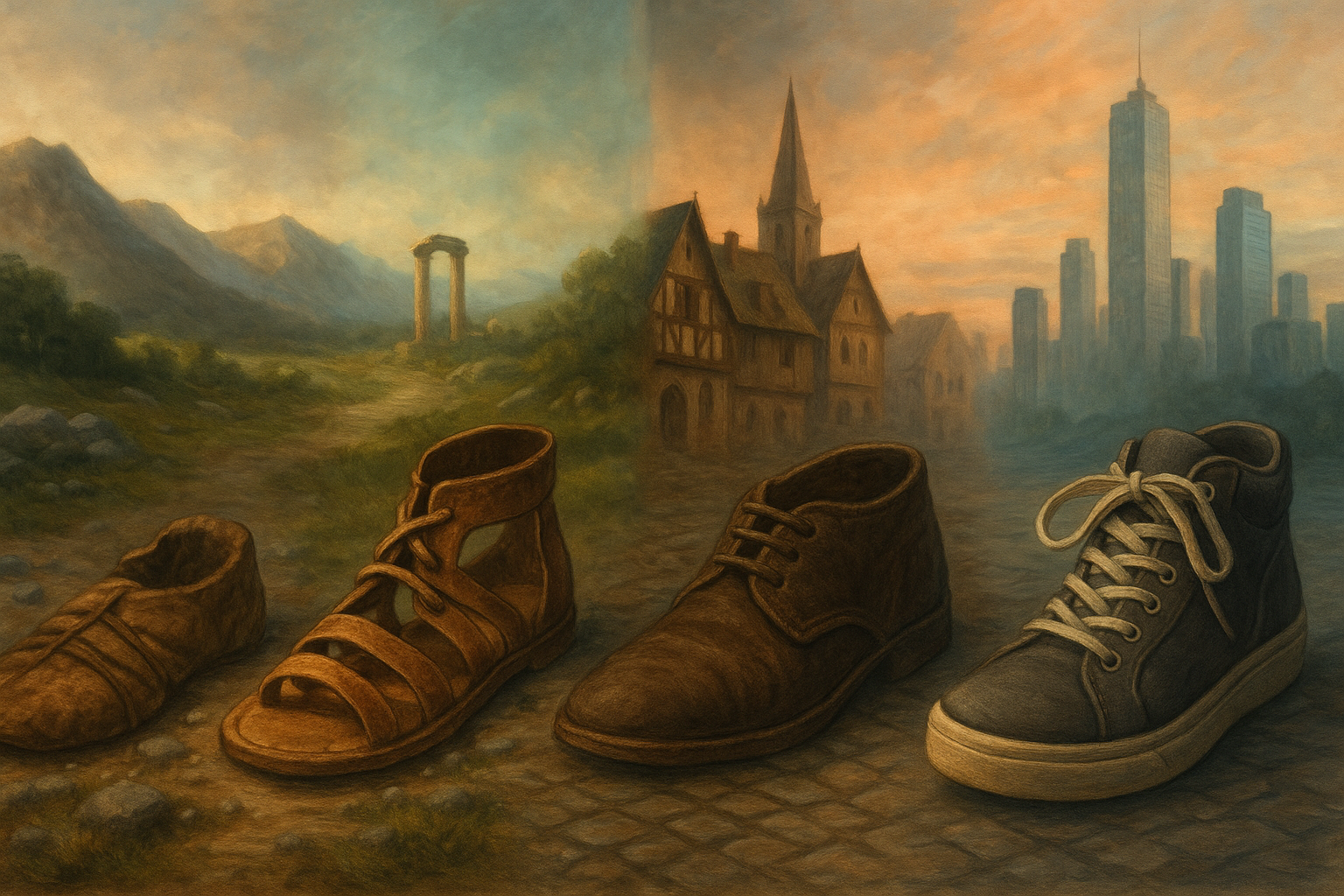The Untold (and Slightly Rebellious) History of Shoelaces
A (Slightly Romanticised) History of Shoelaces.
Shoelaces. Simple, harmless, overlooked. Or so they’d have you believe.
The official story is neat: humans have been tying things to their feet for thousands of years. The oldest known shoelaces were found on Ötzi the Iceman — a 5,000-year-old mummy discovered in the Alps — made from strips of plant fibre threaded through leather. Very practical for crossing mountains without losing your boots.
But think about it… someone, somewhere, decided we all needed to tie our shoes in a particular way. Not buckle them, not glue them, not some clever sliding mechanism. Tying them. And that method spread across continents, cultures, and empires. Why? Because it works? Sure. But maybe also because it’s a little ritual of compliance built into your morning routine.
Fast-forward to the Roman Empire: soldiers wore caligae — sandals laced up the shin. Useful, yes, but also a visual uniform, ensuring the army moved as one, looked as one, and — crucially — could be inspected in seconds for “incorrect” fastening. Footwear became a tool for identifying loyalty and discipline.
In medieval Europe, laces were often colourful ribbons — a status symbol for those who could afford more than plain leather. But sumptuary laws (government rules on what you could and couldn’t wear) meant the “wrong” colour or fabric could get you fined or worse. Even your laces weren’t truly yours.
By the 19th century, with industrialisation in full swing, eyelets became standard. Machines could stamp them out quickly, ensuring shoelaces fit into a system of mass-produced, interchangeable shoes. Efficient for commerce, yes… but also a step towards the uniformity we still live with today.
And in the modern era? Well, shoelaces are still everywhere. From school shoes to military boots, we’ve made peace with this daily knot-tying ritual. But we also live in a time when dress codes still police how we tie them, what colour they can be, and — in some workplaces — whether they’re acceptable at all.
So next time you lace up, take a moment. You’re not just keeping your shoes on — you’re participating in a 5,000-year-old tradition that blends necessity, identity, and just a dash of control.
And maybe, just maybe… leaving them untied once in a while is the smallest act of rebellion you can get away with.
Why Shoelaces Still Matter in a Velcro World
It all begins with an idea.
In an age of slip-ons, zippers, and Velcro, it’s easy to wonder if shoelaces are becoming obsolete. But ask any athlete, hiker, or style-conscious shoe lover, and they’ll tell you — laces still win on both performance and personality.
First, there’s fit. Laces allow for fine adjustments, ensuring your shoe hugs your foot just right. This can mean the difference between all-day comfort and an afternoon of blisters. Velcro straps can’t offer the same precision, and slip-ons often sacrifice support for convenience.
Then, there’s style. Laces are a subtle way to personalise your shoes. Changing the colour, material, or lacing pattern can completely transform a look. They’re not just a fastening system; they’re a fashion accessory in their own right.
Finally, there’s the matter of durability. A good pair of laces can outlast the shoe they’re on, and if they wear out, they’re easily replaced — far cheaper than repairing a broken zipper or worn-out Velcro.
Shoelaces aren’t just a relic of the past; they’re a timeless, adaptable solution to a universal problem: keeping shoes securely on our feet.
The Many Ways the World Ties Its Laces
It all begins with an idea.
Tying your shoelaces may seem universal, but the way it’s done can vary widely across cultures and contexts.
In Japan, there’s an emphasis on neatness and symmetry, with many people tucking laces inside their shoes to keep the look clean. In the UK, the “loop, swoop, and pull” method is a childhood staple, while in the US, many learn the “bunny ears” technique — a playful way to teach kids an essential skill.
The military has its own standards, favouring methods that keep laces tucked in and ends hidden, both for safety and a crisp appearance. On the opposite end of the spectrum, fashion runways sometimes embrace untied laces as an edgy statement — a calculated bit of chaos in an otherwise styled look.
There are also purely functional variations. Runners and hikers may use “heel lock” lacing to prevent slippage, while climbers often rely on double knots for security. Even within one country, you’ll find dozens of patterns — crisscross, straight bar, ladder, and more — each with its own fans.
It’s a reminder that something as simple as tying your shoes can carry cultural, personal, and practical meaning.
Sandals: Shoelacing’s Seasonal Rival
It all begins with an idea.
Every summer, sales of shoelaces dip. The culprit? Sandals — those breezy, backless, and often buckle-free alternatives that promise freedom for your toes.
While sandals have their place, they pose a direct challenge to the shoelace’s reign. Flip-flops, in particular, have perfected the art of minimalism: one strap, one foam sole, and no fastening to speak of. But what they gain in simplicity, they often lose in support, durability, and protection.
Sandals also lack the custom fit that laces provide. There’s no tightening or loosening — if they don’t fit perfectly out of the box, they never will. And while open footwear works in warm weather, it leaves feet exposed to dirt, debris, and the occasional stubbed toe.
As the temperature drops, sandals retreat to the back of the wardrobe, and laces reclaim their rightful place. It’s a seasonal cycle we’ve come to expect — but one we watch closely. After all, we can’t ignore our biggest rival.





